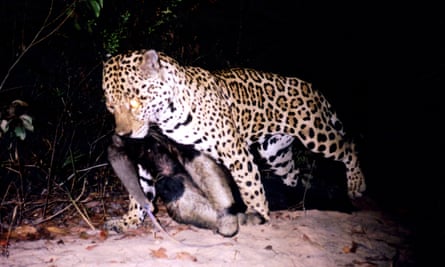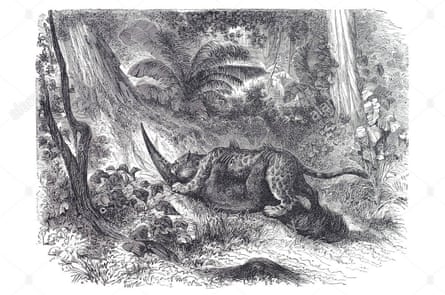As darkness descended over the Peruvian Amazon in 2006, my wife and I listened spellbound while our guide told us the grisly story of the jaguar and giant anteater.
Eyewitnesses, our guide insisted, had found the two foes dead together, embracing like lovers but in mutual destruction – the jaguar’s jaw still drooped around the anteater’s neck where it had pierced its prey’s artery and the anteater’s ten-centimeter-long claws still embedded in the big cat’s flanks. Later, after the spell – and liquor – wore off, I thought it was probably a tall tale, something to tell tourists after the sun sets over the world’s greatest jungle and you’ve all had a few too many. But an incredible new camera trap video proves I may have been wrong to doubt.
The video captures 12 hair-raising seconds of a giant anteater going toe-to-toe with a jaguar – a battle rarely, if ever – seen by human eyes. Taken in Gurupi Biological Reserve in the state of Brazilian state of Maranhão as a part of a survey on jaguars, it shows just how agile and deft a giant anteater can be, like a gangly martial arts master.
“I was in the office, sorting out thousands of camera trap videos, which is really cool but can get a bit boring after the umpteenth time,” Elildo Carvalho Jr., a researcher with the Brazilian National Research Centre for Carnivore Conservation (CENAP). said. “And then, this insane image suddenly jumps out of [the] screen... I felt captured by the incredible [video]. I watched it again and again…Then I called my colleagues, proudly announcing that they would see something [they’d] never seen before.”
In the video we can see the raw physicality – and danger – of such an encounter for both of these threatened and declining species. But, according to Carvalho, we’ll never know how it turned out.
“There were no clues on site, besides we retrieved the camera a month after the event and only saw the footage long after.”

Carvalho believes the two animals probably sized each up and then went on their way, neither willing to test the others’ mettle.
Still he adds, “who knows?”
Jaguar v. Giant Anteater
Scientists have long known that jaguars prey on giant anteaters, but it’s thought that they usually target small or young giant anteaters to avoid a potentially fatal mistake.
One study in 2010 found that giant anteater made up only 3.2 percent of jaguar prey in the Pantanal. But some jaguars – it seems – may be giant anteater specialists. A study in Brazil’s vast grasslands, known as the cerrado, actually found that an astounding 75 percent of jaguar prey was giant anteaters. Jaguars and giant anteaters actually share three ecosystems – the Amazon, the cerrado and the Pantanal – and how they interact may well depend on the habitat and other prey availability.
“The frequency and outcome of [jaguar and giant anteaters] encounters are unknown,” Carvalho said. “Fighting a dangerous prey is always undesirable, so it is reasonable to assume that the jaguar will prefer to attack giant anteaters by surprise and from behind to avoid any trouble.”

He said that battles like the one captured by his camera trap probably only occur when the jaguar messes up its attack or the two animals run into each other unsuspectingly.
But there is at least one camera trap photo of a jaguar carrying a large-bodied, slain giant anteater – not a juvenile – in its maw, proving that sometimes these encounters do end in at least one fatality. The photo isn’t from the Amazon rainforest, but the cerrado.
It’s also not difficult to believe that a giant anteater could actually slay a jaguar. An adult giant anteater can weigh over 40 kilograms – about the size of a small female jaguar – and they will not hesitate to fight when attacked. Like a velociraptor – whose fossilized bones were once discovered in a death grip with a protoceratops – giant anteaters know how to use their spectacular claws. Only the anteater’s are nearly twice as long as the famed dinosaur’s.
Despite it’s somewhat awkward appearance, Carvalho said a giant anteater was “not something to mess with on a dark night.”
In 2012, a man hunting with his two sons and their dogs cornered a giant anteater in Amazonian Brazil. The anteater went into defensive mode, standing with forelimbs and claws splayed.
“The hunter did not fire his rifle because of concern about accidentally shooting his dogs,” reads a report published in Wilderness and Environmental Medicine. “He approached the animal armed with a knife, but was grabbed by its forelimbs.”
Pierced by the long claws, the man bled to death at the scene, while one of his sons, who was also injured, shot the giant anteater five times in order to kill it.
Still, such incidents are notable because they are so rare.
“In Brazil there are no aggressive wild animals, they are not used to [attacking] humans,” said Danilo Kluyber, Head Veterinarian with the Giant Armadillo Conservation Project and Research Associate at Naples Zoo, said.

He should know. Kluyber spends his days capturing and sedating giant anteaters and giant armadillos in order to put tracking collars on them to better understand these little-studied megafauna.
“The capture is the most stressful moment to any wild species, because it means death for them and they will fight for it spending all their energy to survive,” he explained. “During this moment giant anteaters can cause severe injuries to human with their sharp and big claws, their only way to defend themselves. During the giant anteaters capture procedures we use two nets and a safe anesthetic protocol applied right after the individual is immobilized with the nets.”
He said that animals like giant anteaters are only dangerous when cornered and such events usually only occur when humans are trying to hunt them.
Jaguar attacks on humans are also incredibly rare. Jaguars have never been known to become so-called ‘man-eaters’ like some tigers and lions that begin to specialize on hunting people. A jaguar could easily kill humans – it has the strongest bit force of any cat on the planet – it just prefers to avoid us at all costs.
Two threatened species
As with pretty much every species on the planet (aside from arguably malarial mosquitoes), humans are far more dangerous to giant anteaters and jaguars than they could ever be to us.
The IUCN Red List catgorises the jaguar as Near Threatened with extinction while the giant anteater is Vulnerable. Since these two wide-ranging species share many of the same ecosystems, they also share many of the same existential threats.
Number one is habitat destruction. Humans have destroyed about a fifth of the Brazilian Amazon in the last forty years. And the current Brazilian government is in the process of eroding protections that actually helped Brazil dramatically slow deforestation over the last 15 years.
The cerrado, a lesser-known grassland that covers 20 percent of Brazil, is in even worse shape. Half of the ecosystem has been lost to vast soy farms and cattle ranches. At the same time, little of the cerrado has actually been set aside as protected areas.
Meanwhile, a study in 2012 estimated that humans have deforested 15 percent of the Pantanal – the world’s largest wetland – for cattle ranching and intensive agriculture.
Jaguars also face a drastically depleted prey base as many forests and ecosystems are overhunted. The big cats are commonly persecuted as pests on ranches, and, although rarely killed for their skins anymore, they are still poached for their body parts – paws and teeth – to be sold illegally.
In contrast, giant anteaters – considered one level more threatened than jaguars – are hunted as bushmeat throughout their range. Scientists are also just realizing how imperiled the species – and other Brazilian wildlife – are by collisions with cars.
“Shockingly, giant anteaters are among the top species killed on these roads, and road mortalities pose a serious threat to long-term population viability,” Kluyber said, pointing to a not-yet published study that recorded 135 giant anteaters killed by car collisions in the cerrado. The species was one of the top three animals killed by cars and made up over 10 percent of all mortality.
Habitat in the cerrado is “highly fragmented,” Kluyber said, which forces animals to move long distances and frequently cross numerous roads.
Camera traps in an age of wildlife decline
But even as populations of jaguars and giant anteaters decline, we are seeing more of them than ever before – we are learning more than we ever knew. All thanks to the invention of a camera that takes pictures or video when an animal triggers an infrared sensor, the modern day camera trap.
“Camera-traps are revolutionizing our understanding of cryptic rainforest animals,” Carvalho said. “They are allowing us to get information on the distribution, abundance, activity patterns and behaviour of these species which would be impossible to obtain otherwise.”
But camera traps may prove good for more than science. They could also be a largely-untapped, but potentially huge, resource to get the public to see species anew and to actually care about their survival, especially those cryptic, rarely-seen in person species. For example, it was only using camera traps that Planet Earth II was able to get its stunning videos of snow leopards. For many species, the first time they’ve ever been caught on film was because of a camera trap hidden in a forest somewhere.
“With a little luck, [camera traps] also give us beautiful photos or amazing videos such as this one,” Carvalho said.
The opportunity now is for conservationists to somehow use their photos and videos to raise awareness as well as gain supporters and funds. Scientists have proven endlessly creative in using camera traps to gather data, but using them as PR tools for saving species has not jumped into the mainstream.
Indeed, camera traps are revealing lost worlds – hundreds-of-thousands of lost worlds – to scientists. The images and videos coming from the uncountable number of camera traps sitting around the world every day are as incredible and impressive as anything coming out of NASA. For, in an age in which we think we know everything, they prove just how little – how very little – we know about the planet we actually inhabit, how much there remains to learn and discover, and how much we have to lose.
Comments (…)
Sign in or create your Guardian account to join the discussion